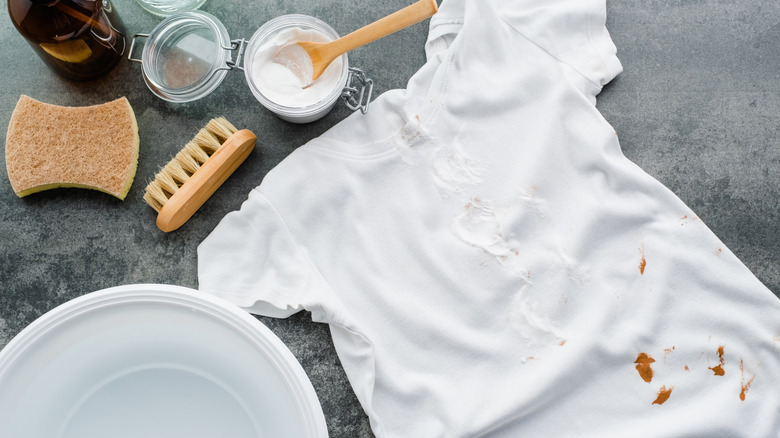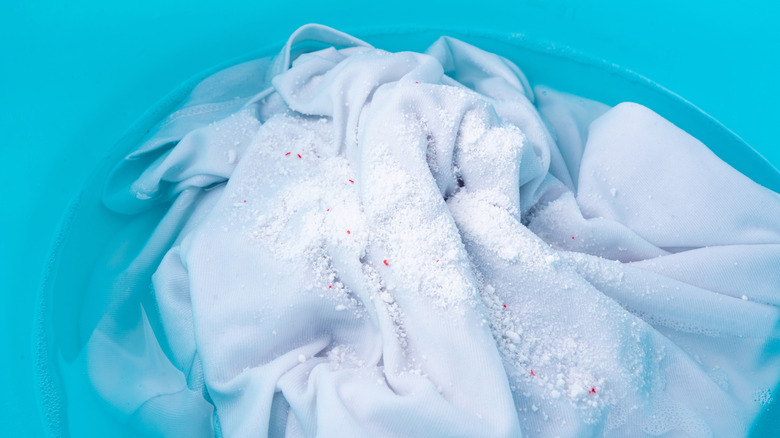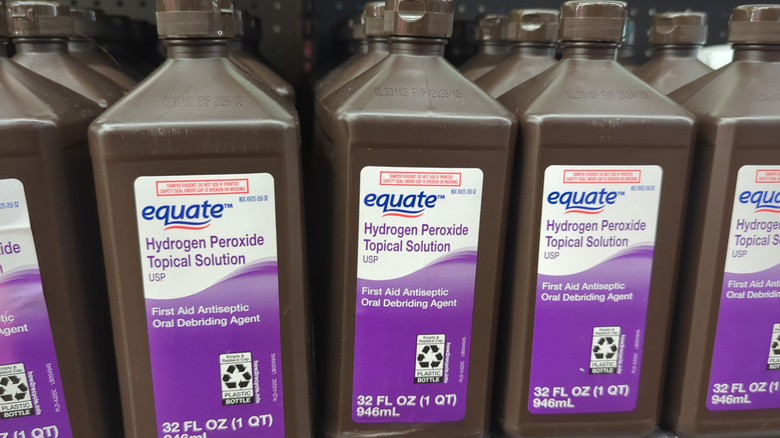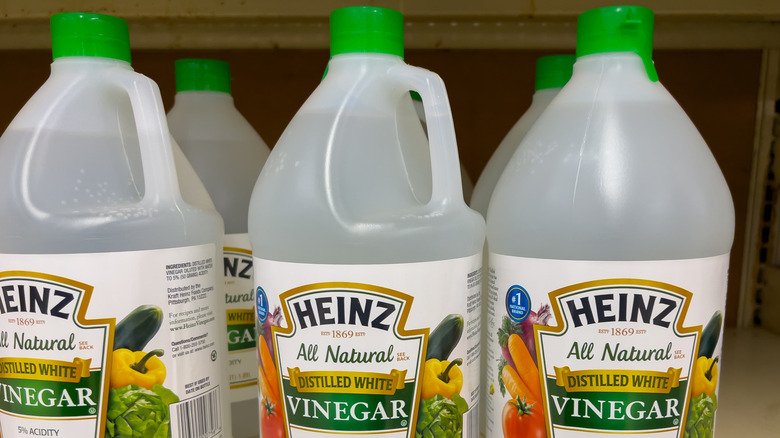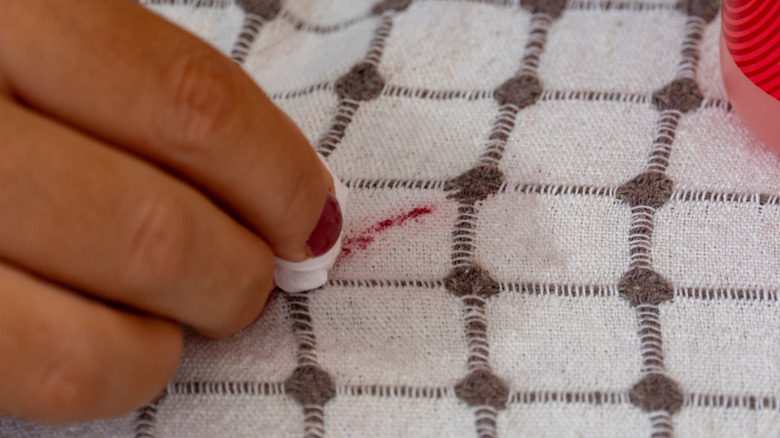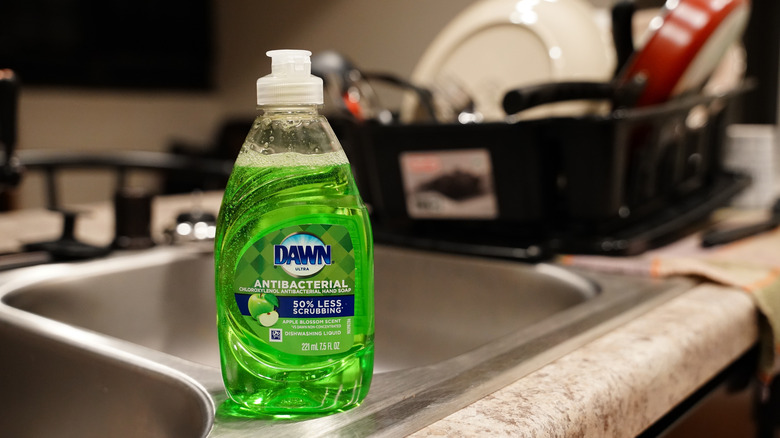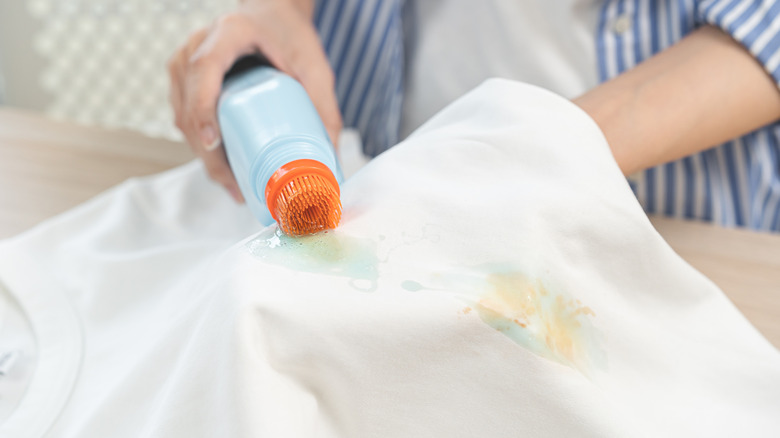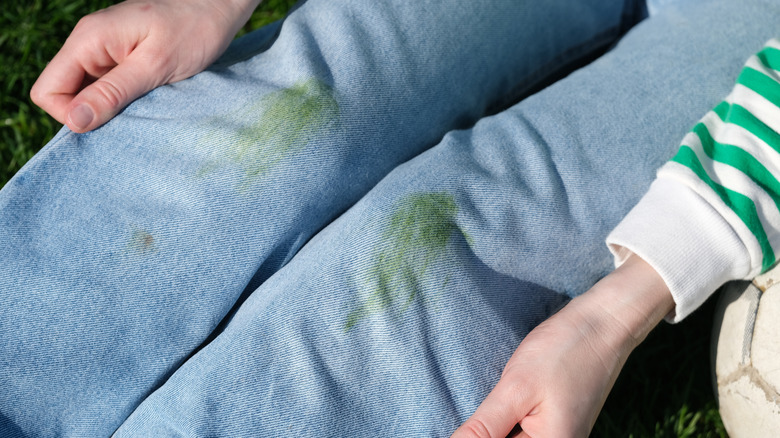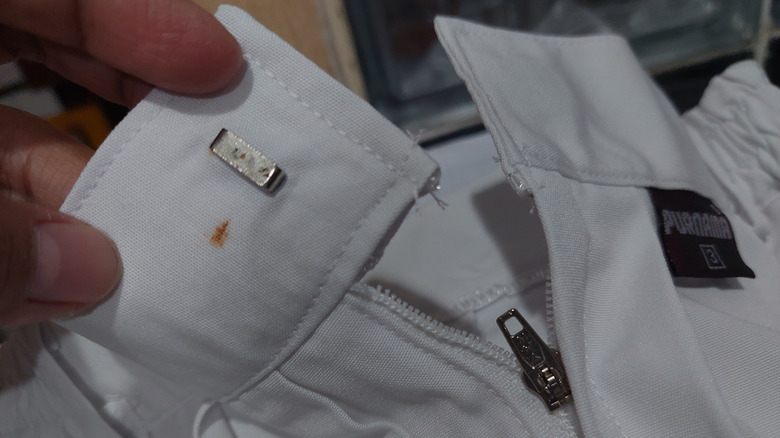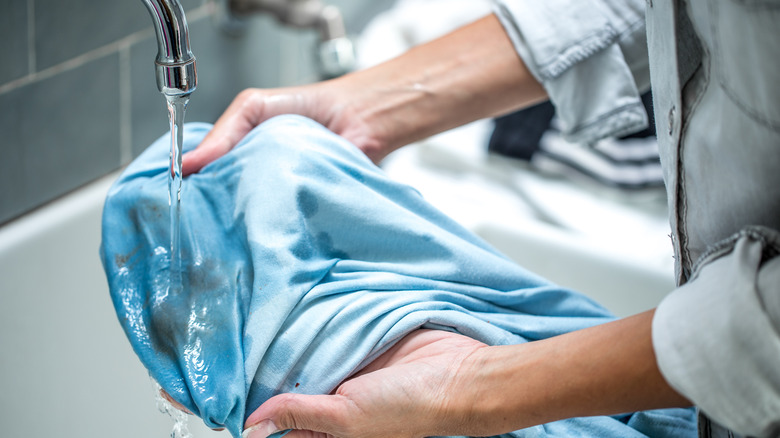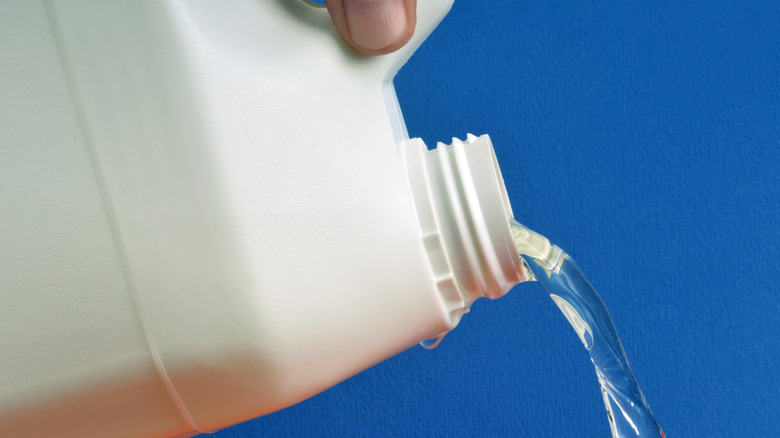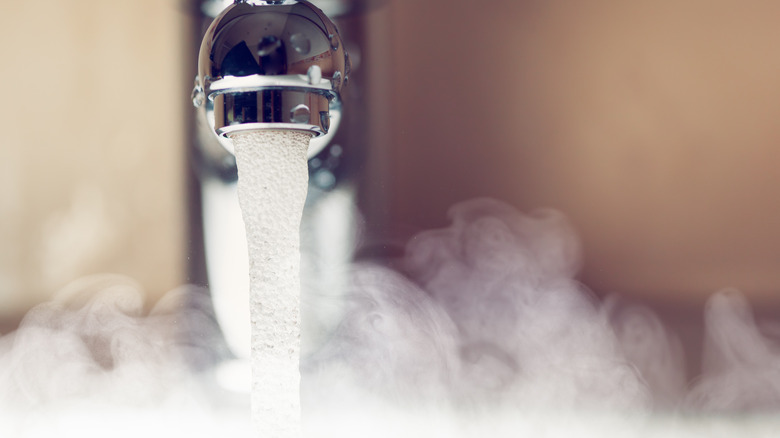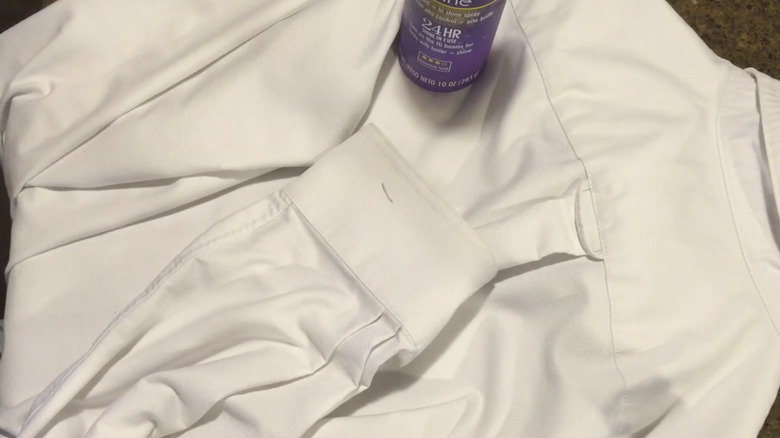10 Ways To Get Dried Set-In Stains Out Of Clothes (And 2 Ways That Aren't Worth Trying)
Few laundry frustrations compare to discovering a stubborn stain that's already been through the wash. Maybe it's a drop from your favorite morning java, a splash of red from your latest wine club adventure, or grease from some home DIY that has somehow set deep into the fabric. Once that stain has dried, many people consider simply retiring the item of clothing or banishing it to garden and garage work. Before you simply give up, though, there are ways to bring those clothes back to life to once again be stain-free.
The right combination of household staples and a few handy stain removal hacks can remedy a blemish that has already dried and set. The trick lies in understanding what kind of stain you're dealing with and choosing the best method for that specific culprit. What works for one stain may not necessarily work for another. From kitchen staples like dish soap and vinegar to specialized cleaners like oxygen bleach, these solutions use chemistry, not just elbow grease, to lift out what water and detergent can't do alone. With a little patience and the right approach, you can make even the most set-in stains disappear. In this article, we shine the light on a variety of ways that you can remove stains from your clothing even after the stains have dried. We also talk about a few methods you may have heard about that you'll want to avoid.
Try out oxygen bleach for organic stains
Oxygen bleach is one of the most effective and fabric-safe ways to tackle old, set-in stains caused by organic substances like coffee, wine, grass, and sweat. How does it work, though? The magic lies in sodium percarbonate, a cleaning agent that makes up oxygen bleach. When combined with water, sodium percarbonate releases hydrogen peroxide. This chemical reaction breaks down the molecular bonds of organic stains, lifting discoloration from the fibers without weakening them. Unlike chlorine bleach, which uses harsher oxidizing agents that can damage or fade colored fabrics, oxygen bleach works gently through an oxidation process that targets the stain molecules while leaving dyes and fibers intact. For anyone tackling a child's shirt that is stained with grass and blood after a fall, this is a massive win.
So, how do you use oxygen bleach to remove stains from clothing? If you're tackling a blood stain, start by dissolving the recommended amount in water before adding your stained clothing. If it's a yellow stain from food or sweat, you'll want to soak it in the oxygen bleach water for quite a while before the normal wash cycle. Note that some fabrics, including suede, silk, and wool, are not suited to oxygen bleach. Always follow the instructions on the product you're going with.
Out of oxygen bleach? Grab the hydrogen peroxide
If you're out of oxygen bleach, hydrogen peroxide can be an excellent substitute, especially when looking for a product that cleans dried blood stains. Like oxygen bleach, it works through oxidation, breaking down the proteins and color compounds that give blood its deep reddish-brown mark once dried. When hydrogen peroxide reacts with the enzymes in blood, it releases oxygen bubbles that help lift the stain from fabric fibers. One important thing to note is that because hydrogen peroxide is a stronger oxidizer than most laundry-safe oxygen bleaches and not purposely built for cleaning clothing, it should be used with care, especially on colored or delicate fabrics that may lighten or fade.
To remove a blood stain that has dried, take a clean sponge and wet it with the hydrogen peroxide. Make sure that you don't soak it — just make it damp. Then, gently apply the sponge to the stain, blotting it until you start to see the stain fizz. That's the sign you're looking for to show that the hydrogen peroxide is working its magic. You'll then need to rinse the item of clothing off with cold water. If you still see the stain, repeat the process. For the hydrogen peroxide, go with a 3% solution to be on the safe side.
Use vinegar as a pretreatment for acidic-based stains
When it comes to some stains, opposing forces are a good thing — specifically opposite pH. Enter white vinegar. While most people think of vinegar as a household deodorizer or cooking staple, it can also be an effective pretreatment for certain types of stains, particularly those caused by acidic substances like wine, tea, coffee, and soft drinks. The mild acetic acid in white vinegar helps to break down these tannin-based stains by loosening their grip on fabric fibers. Some professional dry cleaners use it as part of a "like-treats-like" process, acting as a pretreatment on clothing. Unlike harsher chemical cleaners, vinegar is gentle enough for most washable fabrics, though it's best avoided on sensitive materials like silk or acetate.
What is important to note is that vinegar doesn't necessarily remove stains fully on its own; it prepares the fabric so that follow-up cleaning agents, like oxygen bleach or enzymatic detergents, can work more effectively. For red wine stains, sponge the stained area with white vinegar until it disappears. Then, put it through a normal wash. For underarm perspiration stains, take white vinegar and rub it on the stained area, then do a normal wash. If the stain is still there after that, repeat the process.
Acetone can effectively remove nail polish smudges and ink stains
When it comes to stubborn ink or nail polish stains, acetone can be a lifesaver. Found in many nail polish removers, acetone is a powerful solvent that breaks down complex chemical compounds, including the pigments, resins, and binders found in inks, paints, and cosmetics. These substances are often oil- or alcohol-based, meaning water alone can't dissolve them. Acetone works by softening and dissolving these tough components, allowing the stain to be lifted from fabric fibers. If you have a nail polish smudge on your dress or if a pen has leaked ink on the front of your shirt pocket, acetone can do the trick.
For nail polish or ink stains on clothing, if it hasn't dried yet, try to dab up as much as you can with a paper towel — if it has already dried, move to the next step. Then, take a cotton swab and dab it into the acetone before blotting the stain to remove it. Take note that acetone will dissolve cellulose triacetate fabrics (semi-synthetic, plant-based fiber), so don't use it on items that contain this (the lining of a tie, for example). It's best to first test it on an inconspicuous part of the garment.
Dish soap for grease
If you've ever splattered cooking oil or butter onto your favorite shirt, dish soap can be one of the most effective tools for tackling the stain — even after it's dried. The reason is simple chemistry: dish soap is specifically formulated to cut through fats and oils. Its surfactants (short for surface-active agents) work by surrounding grease molecules and breaking their surface tension, allowing them to be lifted away from fabric fibers and rinsed out with water. This makes it particularly useful for greasy stains caused by food, car maintenance, or body oils that ordinary laundry detergent might leave behind. Unlike harsher solvents, dish soap is gentle enough for most fabrics but powerful enough to get rid of tough oils that can't be removed by detergent alone. The trick, however, is to use it with the combination of ammonia, baking soda, or a dry cleaning solvent.
To remove a set-in grease stain, start by applying a commercial dry-cleaning solvent to the mark. Then, apply a small drop of liquid dish soap directly to the affected area and gently work it in with your fingers or a soft toothbrush. Next, take baking soda and sprinkle it on the stain, on top of the dish soap that you've already applied. This will help to absorb the oil residue that may be left behind. Then, soak the item in warm water for around 30 minutes before washing with your usual detergent. If the stain remains after all this, repeat the process. Once the stain has vanished, air-dry the garment instead of using a dryer.
Use glycerine to lubricate waterborne stains
While you may have been making use of glycerine to moisten up your baking treats, there is another surprising benefit of it: taking out waterborne stains. We're talking about the pesky stains left behind by red wine, cola, and some inks. A waterborne stain is essentially from a substance that uses water as the primary solvent. In other words, what it is mostly made up of. They are generally far easier to remove than oil-based stains. Why is glycerine so effective in removing waterborne stains, though? First up, it's a natural, water-soluble compound that works as a humectant, meaning it attracts and holds moisture. It basically lubricates the marked area. This property helps to rehydrate dried stains, softening the residue so it can be more easily lifted from fabric fibers. This makes it especially useful for older or stubborn waterborne marks that have hardened over time.
To use glycerine on set-in stains, apply a few drops directly to the affected area and let it sit for around 30 minutes. Giving it some time to absorb will let the glycerine penetrate the fibers and loosen the stain. After 30 minutes, rinse the glycerine off with cold water. Then, put the garment in the wash on a normal cycle. If the stain persists, repeat the process.
Use an enzyme stain remover for protein-based stains
Protein-based stains — like blood, sweat, milk, or grass — are notoriously tough because they bond tightly to fabric fibers. They aren't impossible to remove, though, if you have the right trick up your sleeve. The key to breaking protein-based stains down lies in enzyme-based cleaners. These products contain biological enzymes that digest the proteins in the stain, effectively loosening them from the fabric so they can be rinsed away. Many of the detergents on the market in the U.S. have these enzymes in them, being specifically formulated to target organic stains. So, if you're looking to tackle a blood or grass stain, make sure to look out for a stain remover that says it contains enzymes on the packing — you'll want to look out for ingredients like protease and lipase.
To treat a protein-based stain, it is helpful to first pretreat it. Gently blot the affected area first (don't rub), then apply an enzyme-based cleaner directly to the spot. You'll then need to let it sit for a while. How long depends on the product you are using, so you'll need to follow the instructions (this may vary from a few minutes to a few hours). Next, rinse the item of clothing in cold water and then put it on a normal wash using a good detergent. Any of the major brands will do.
Try a fabric-safe rust remover for rust stains
While set rust stains on your clothing may seem like a lost cause, there is one type of product that has been shown to do the job: fabric-safe rust remover. While it may sound like a risky move, considering what these products do to rust, there are products that are designed to get the work done without causing any damage to the fibers of the garment. The way it works is that the rust remover eliminates iron oxide, the unwanted culprit in rust stains. Commercial rust stain removers are specifically formulated to dissolve rust, allowing it to be rinsed out thoroughly. Just make sure that you don't use a chlorine bleach because these are known to make rust stains even worse.
If you have a rust stain on your clothing, get your hands on a fabric-safe rust remover and start by first testing it on an inconspicuous area. Following the instructions on the packaging, apply it to the rust stain. Then, rinse the item in cold water before putting it in the washer on your usual cycle. Be careful with how you use the rust remover, as it can damage other materials like porcelain and enamel. If you're out of a commercial rust remover, vinegar can do the trick. Create a paste with vinegar and salt, and spread it on the stain. Next, pour some boiling water over the stain, which now has the paste, and let it dry. Once dry, put it through the usual wash cycle.
Ice or cold water for adhesive stains
The simplest tip we can offer you in this article is right inside your fridge. Applying ice or cold water is a basic but surprisingly effective first step for removing stains made up of adhesive residue. These are most often stains left behind from tape, labels, or a messy glue gun experiment. The cold hardens the adhesive, making it brittle so you can gently scrape it away or peel most of it off without causing damage to the fabric. This tip is particularly useful for delicate materials where heat might not be the best choice.
Once the bulk of the residue is removed, you'll want to use a prewash treatment to get to the rest of it. Following the instruction on the prewash product, leave the item to sit for a while. Then all that is left is to rinse it off and put it into a normal wash cycle. If there is still residue left after drying, repeat the process.
Bleach can tackle most stains, but use with care
Bleach is a powerful tool in the fight against old, set-in stains, credited to its chemical action that whitens, brightens, and loosens soils from fabrics through oxidation. The magic is in the chlorine and sodium hypochlorite that most household bleaches contain, which actually changes the chemical structure of the stain. It's a really fancy way of saying that the bleach breaks the stains down into simpler forms so that they no longer show. Not all bleaches are created equal, so it really depends on the type of clothing you're looking to remove the stain from. To get rid of sweat stains, you'll want to use oxygen-based bleach but avoid using it on wool, suede, and silk. The other bleach is chlorine bleach, but you'll need to check the clothing label to check that you can use it safely with the specific fabric. To be on the safe side, we recommend sticking with oxygen-based bleach.
To use oxygen-based bleach to tackle a stain on your clothing, first always check the label. You'll want to presoak the garment first, which you can do by following the instructions on the specific brand you've gone with. Don't pour the bleach straight onto the clothing — mix it with the water before adding the item. Then, just run it through the normal wash cycle. An important point to note is to never use bleach on sunscreen stains — this can make the stain much worse.
What not to do — hot water
Upon finding a dreaded stain on your clothing, your first instinct might be to grab the hottest water possible — but that's often the worst thing you can do. Hot water can actually "cook" certain stains into the fabric, making them far harder (and sometimes impossible) to remove. The thing with heat is that it causes proteins, like those found in blood, milk, or eggs, to coagulate, binding them tightly to fabric fibers. If your kids have been rumbling around outside and have come in with grass stains, it's the same principle — you'll only make the stain more difficult to remove.
Instead, always start with cold water, especially if you're unsure what caused the stain. Cold water helps lift debris and dilute the stain without locking it in. Once you've treated the spot and confirmed it's gone, you can safely launder the garment as usual — but reaching for hot water too soon could undo your chances of saving it. There is, however, a time and place for using hot water on stains. For stains left behind by oil-based food, for example, hot water will help to liquefy the stain — in other words, make it more liquid.
What not to do — hairspray for ink stains
One of the stain removal myths in circulation over recent years is that hairspray can remove ink stains. Tread (or treat) with caution! While you may have seen it doing the rounds on social media, there's a good reason why you shouldn't use hairspray on an ink stain. While the online comments say it works, the experts have a very different opinion. While the logic may suggest that alcohol-based hairsprays will lift the stain, unless it's done by a professional, there's a good chance it will actually make it worse, causing the stain to run and enlarge.
Even if you disagree (we don't suggest you put it to the test), most brands these days looking to cater to broader consumer preferences have removed alcohol from their products. You are far better off trying the clothing stain cleaning tip we mentioned earlier — using acetone. This strong solvent will get the job done, but make sure to check that the garment isn't made with plant-based fiber as the acetone will damage these fibers.
